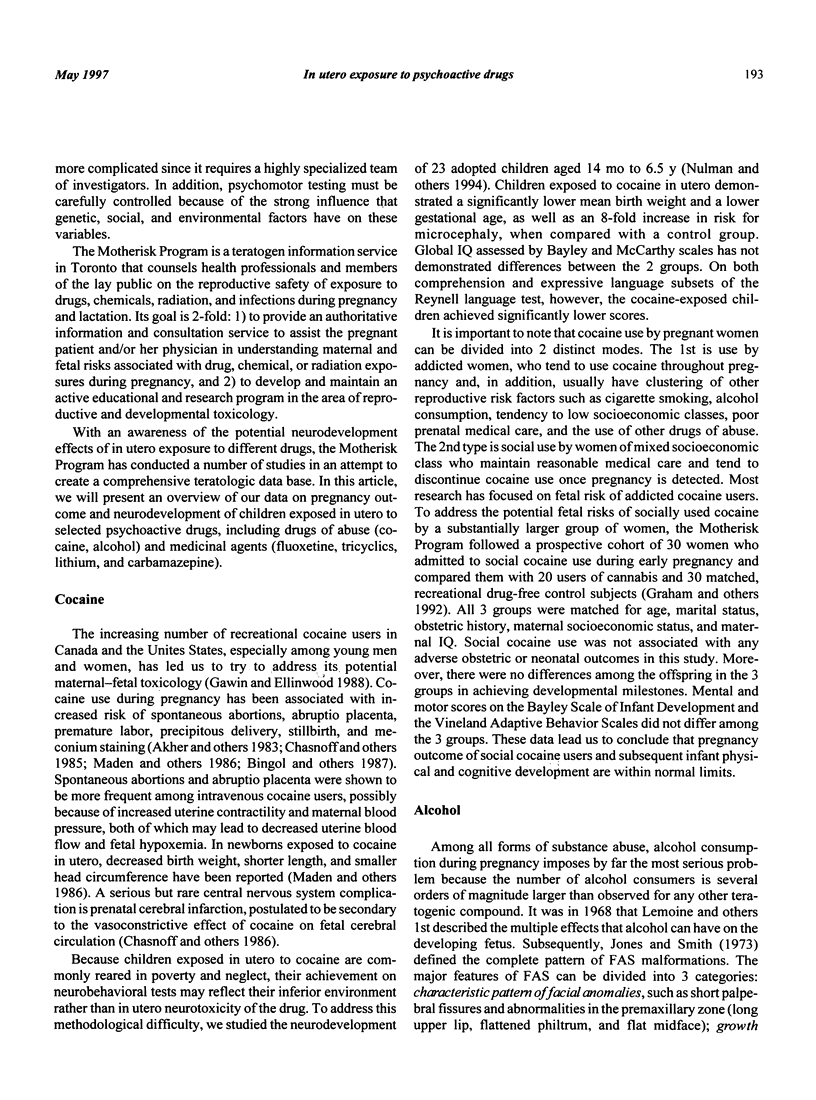Abstract
This paper presents an overview of the Motherisk Program data on pregnancy outcome and neurodevelopment of children exposed in utero to selected psychoactive drugs. First, the use of cocaine during pregnancy has been associated with increased risk of spontaneous abortions, abruptio placenta, premature labor, and stillbirth. Twenty-three adopted children exposed in utero to cocaine demonstrated an 8-fold increase in risk for microcephaly compared with controls. Global intelligence quotients (IQ) did not differ between the 2 groups, but the cocaine-exposed children achieved significantly lower scores on the Reynell language test. Second, the long-term neurobehavioral effects of fetal alcohol syndrome (FAS) were studied in 384 children to show that alcohol-induced brain insults, which consist of attention and memory deficits together, and poor adaptability and organization are not attenuated with age. Third, the rates of major malformations in children exposed in utero to fluoxetine, tricyclic antidepressants, and nonteratogenic drugs did not differ or exceed the expected rates in the general population. A 2nd phase of this study established the safety of antidepressants during pregnancy by demonstrating that the mean IQ and language scores are comparable in the 3 groups. A level 2 ultrasonography is recommended in cases of in utero exposure to lithium and carbamazepine because of an increased risk of cardiac malformations and spina bifida, respectively.
Full text
PDF




Selected References
These references are in PubMed. This may not be the complete list of references from this article.
- Acker D., Sachs B. P., Tracey K. J., Wise W. E. Abruptio placentae associated with cocaine use. Am J Obstet Gynecol. 1983 May 15;146(2):220–221. doi: 10.1016/0002-9378(83)91060-8. [DOI] [PubMed] [Google Scholar]
- Bingol N., Fuchs M., Diaz V., Stone R. K., Gromisch D. S. Teratogenicity of cocaine in humans. J Pediatr. 1987 Jan;110(1):93–96. doi: 10.1016/s0022-3476(87)80297-4. [DOI] [PubMed] [Google Scholar]
- Chambers C. D., Johnson K. A., Dick L. M., Felix R. J., Jones K. L. Birth outcomes in pregnant women taking fluoxetine. N Engl J Med. 1996 Oct 3;335(14):1010–1015. doi: 10.1056/NEJM199610033351402. [DOI] [PubMed] [Google Scholar]
- Chasnoff I. J., Burns W. J., Schnoll S. H., Burns K. A. Cocaine use in pregnancy. N Engl J Med. 1985 Sep 12;313(11):666–669. doi: 10.1056/NEJM198509123131105. [DOI] [PubMed] [Google Scholar]
- Chasnoff I. J., Bussey M. E., Savich R., Stack C. M. Perinatal cerebral infarction and maternal cocaine use. J Pediatr. 1986 Mar;108(3):456–459. doi: 10.1016/s0022-3476(86)80896-4. [DOI] [PubMed] [Google Scholar]
- Gawin F. H., Ellinwood E. H., Jr Cocaine and other stimulants. Actions, abuse, and treatment. N Engl J Med. 1988 May 5;318(18):1173–1182. doi: 10.1056/NEJM198805053181806. [DOI] [PubMed] [Google Scholar]
- Graham K., Feigenbaum A., Pastuszak A., Nulman I., Weksberg R., Einarson T., Goldberg S., Ashby S., Koren G. Pregnancy outcome and infant development following gestational cocaine use by social cocaine users in Toronto, Canada. Clin Invest Med. 1992 Aug;15(4):384–394. [PubMed] [Google Scholar]
- Jacobson S. J., Jones K., Johnson K., Ceolin L., Kaur P., Sahn D., Donnenfeld A. E., Rieder M., Santelli R., Smythe J. Prospective multicentre study of pregnancy outcome after lithium exposure during first trimester. Lancet. 1992 Feb 29;339(8792):530–533. doi: 10.1016/0140-6736(92)90346-5. [DOI] [PubMed] [Google Scholar]
- Jones K. L., Smith D. W. Recognition of the fetal alcohol syndrome in early infancy. Lancet. 1973 Nov 3;302(7836):999–1001. doi: 10.1016/s0140-6736(73)91092-1. [DOI] [PubMed] [Google Scholar]
- Long W. A., Willis P. W., 4th Maternal lithium and neonatal Ebstein's anomaly: evaluation with cross-sectional echocardiography. Am J Perinatol. 1984 Jan;1(2):182–184. doi: 10.1055/s-2007-999999. [DOI] [PubMed] [Google Scholar]
- Madden J. D., Payne T. F., Miller S. Maternal cocaine abuse and effect on the newborn. Pediatrics. 1986 Feb;77(2):209–211. [PubMed] [Google Scholar]
- Nulman I., Rovet J., Altmann D., Bradley C., Einarson T., Koren G. Neurodevelopment of adopted children exposed in utero to cocaine. CMAJ. 1994 Dec 1;151(11):1591–1597. [PMC free article] [PubMed] [Google Scholar]
- Nulman I., Rovet J., Stewart D. E., Wolpin J., Gardner H. A., Theis J. G., Kulin N., Koren G. Neurodevelopment of children exposed in utero to antidepressant drugs. N Engl J Med. 1997 Jan 23;336(4):258–262. doi: 10.1056/NEJM199701233360404. [DOI] [PubMed] [Google Scholar]
- Pastuszak A., Schick-Boschetto B., Zuber C., Feldkamp M., Pinelli M., Sihn S., Donnenfeld A., McCormack M., Leen-Mitchell M., Woodland C. Pregnancy outcome following first-trimester exposure to fluoxetine (Prozac) JAMA. 1993 May 5;269(17):2246–2248. [PubMed] [Google Scholar]
- Rosa F. W. Spina bifida in infants of women treated with carbamazepine during pregnancy. N Engl J Med. 1991 Mar 7;324(10):674–677. doi: 10.1056/NEJM199103073241006. [DOI] [PubMed] [Google Scholar]
- Scolnik D., Nulman I., Rovet J., Gladstone D., Czuchta D., Gardner H. A., Gladstone R., Ashby P., Weksberg R., Einarson T. Neurodevelopment of children exposed in utero to phenytoin and carbamazepine monotherapy. JAMA. 1994 Mar 9;271(10):767–770. [PubMed] [Google Scholar]
- Streissguth A. P., Bookstein F. L., Sampson P. D., Barr H. M. Neurobehavioral effects of prenatal alcohol: Part III. PLS analyses of neuropsychologic tests. Neurotoxicol Teratol. 1989 Sep-Oct;11(5):493–507. doi: 10.1016/0892-0362(89)90026-3. [DOI] [PubMed] [Google Scholar]
- Zalzstein E., Koren G., Einarson T., Freedom R. M. A case-control study on the association between first trimester exposure to lithium and Ebstein's anomaly. Am J Cardiol. 1990 Mar 15;65(11):817–818. doi: 10.1016/0002-9149(90)91398-p. [DOI] [PubMed] [Google Scholar]


